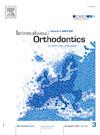Invisalign®矫治器对腭移位上颌侧切牙矫治后的垂直变化:回顾性研究
IF 1.9
Q2 DENTISTRY, ORAL SURGERY & MEDICINE
引用次数: 0
摘要
本研究的目的是检查计划垂直定位腭移位的上颌侧切牙(PDMLI)在最初使用一系列Invisalign®(Align Technology, Santa Clara, california)矫正器的患者中的效果。方法使用Geomagic Control X®(版本2017.0.3;3D系统,岩石山,SC)。临床意义根据美国正畸客观分级系统确定。结果63例患者符合纳入标准,其中pdmli患者90例。在初始系列矫直器磨损后,pdmli的计划垂直位置与实际垂直位置的平均差异(SD)为0.40 (0.5)mm。39例(43.3%)pdmli的计划垂直位置与实际垂直位置之间存在显著的临床差异。挤压比侵入更不准确,特别是当伴有邻近中切牙的计划侵入时。线性回归分析显示,年龄、性别、附着物的存在和计划根扭矩的大小对垂直定位的准确性没有显著影响(P >;P < 0.05),而PDMLI冠的计划前后运动则没有(P <;0.01)。结论初始一系列Invisalign®治疗后PDMLIs的垂直位置与计划位置有显著差异,43.3%具有临床显著性差异。前后运动量与实现计划垂直运动的有效性显著相关。本文章由计算机程序翻译,如有差异,请以英文原文为准。
Vertical changes following alignment of palatally displaced maxillary lateral incisors with the Invisalign® appliance: A retrospective study
Introduction
The aim of this study was to examine the efficacy of planned vertical positioning of palatally displaced maxillary lateral incisors (PDMLI) in patients treated with an initial series of Invisalign® (Align Technology, Santa Clara, Calif) aligners.
Methods
The pre-treatment digital models, and models representing the planned and achieved treatment outcomes of adult patients, prescribed an initial series of Invisalign® aligners were analysed, using Geomagic Control X® (version 2017.0.3; 3D Systems, Rock Hill, SC). Clinical significance was determined according to the American Board of Orthodontics Objective Grading System.
Results
A total of 63 patients, comprising 90 PDMLIs, met the inclusion criteria. The mean (SD) difference between the planned and achieved vertical position of PDMLIs following wear of the initial series of aligners was 0.40 (0.5) mm. A clinically significant discrepancy between planned and achieved was observed in 39 (43.3%) PDMLIs. Extrusion was less accurately achieved than intrusion, particularly when accompanied by planned intrusion of the adjacent central incisor. Linear regression analysis showed that age, sex, presence of an attachment, and amount of planned root torque did not significantly influence the accuracy of vertical positioning (P > 0.05), whereas planned antero-posterior movement of the PDMLI crown did (P < 0.01).
Conclusions
The achieved vertical position of PDMLIs following an initial series of Invisalign® treatment differed significantly from the planned position with 43.3% showing a clinically significant difference. The amount of antero-posterior movement was significantly related to the efficacy in achieving the planned vertical movement.
求助全文
通过发布文献求助,成功后即可免费获取论文全文。
去求助
来源期刊

International Orthodontics
DENTISTRY, ORAL SURGERY & MEDICINE-
CiteScore
2.50
自引率
13.30%
发文量
71
审稿时长
26 days
期刊介绍:
Une revue de référence dans le domaine de orthodontie et des disciplines frontières Your reference in dentofacial orthopedics International Orthodontics adresse aux orthodontistes, aux dentistes, aux stomatologistes, aux chirurgiens maxillo-faciaux et aux plasticiens de la face, ainsi quà leurs assistant(e)s. International Orthodontics is addressed to orthodontists, dentists, stomatologists, maxillofacial surgeons and facial plastic surgeons, as well as their assistants.
 求助内容:
求助内容: 应助结果提醒方式:
应助结果提醒方式:


